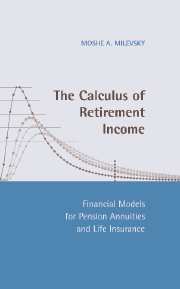Book contents
- Frontmatter
- Contents
- List of Figures and Tables
- I MODELS OF ACTUARIAL FINANCE
- 1 Introduction and Motivation
- 2 Modeling the Human Life Cycle
- 3 Models of Human Mortality
- 4 Valuation Models of Deterministic Interest
- 5 Models of Risky Financial Investments
- 6 Models of Pension Life Annuities
- 7 Models of Life Insurance
- 8 Models of DB vs. DC Pensions
- II WEALTH MANAGEMENT: APPLICATIONS AND IMPLICATIONS
- III ADVANCED TOPICS
- Bibliography
- Index
7 - Models of Life Insurance
from I - MODELS OF ACTUARIAL FINANCE
Published online by Cambridge University Press: 06 July 2010
- Frontmatter
- Contents
- List of Figures and Tables
- I MODELS OF ACTUARIAL FINANCE
- 1 Introduction and Motivation
- 2 Modeling the Human Life Cycle
- 3 Models of Human Mortality
- 4 Valuation Models of Deterministic Interest
- 5 Models of Risky Financial Investments
- 6 Models of Pension Life Annuities
- 7 Models of Life Insurance
- 8 Models of DB vs. DC Pensions
- II WEALTH MANAGEMENT: APPLICATIONS AND IMPLICATIONS
- III ADVANCED TOPICS
- Bibliography
- Index
Summary
A Free (Last) Supper?
A few years ago, a clever friend of mine borrowed $100,000 from the bank at a fixed interest rate of 5% per year. He promised to pay the loan back when he (eventually) died. The bank was willing to lend him the money under these conditions because he used part of the $100,000 to purchase a life insurance policy with a death benefit of $100,000, with the bank listed as the beneficiary. Apparently, this transaction still left him with enough money to purchase an immediate pension annuity that would cover his periodic interest payments of $5,000 each year and then some. In other words, even after buying the life insurance policy and the annuity, he still had some money left over. This sounds like a free lunch to me. In this chapter I will discuss the characteristics and valuation of various types of life insurance policies and investigate whether this transaction is possible.
Market Prices of Life Insurance
Life insurance is the mirror image of pension annuities and is the subject and focus of this chapter. The word “life” insurance is a misnomer, since this type of insurance pays off only upon death. But then “death insurance” is a much tougher sell even for marketing specialists.
Table 7.1 provides a sample of actual life insurance quotes. It displays the fixed annual premiums that males and females would have to pay at various ages in order to obtain $100,000 of life insurance coverage that would pay off at death.
- Type
- Chapter
- Information
- The Calculus of Retirement IncomeFinancial Models for Pension Annuities and Life Insurance, pp. 138 - 163Publisher: Cambridge University PressPrint publication year: 2006
- 2
- Cited by



